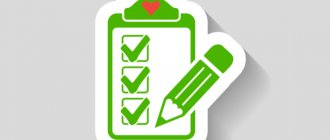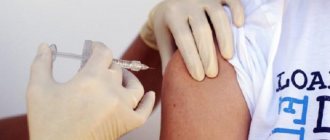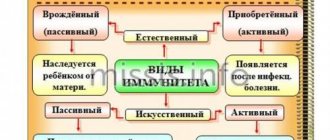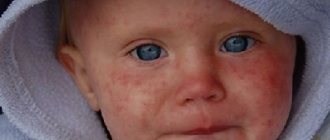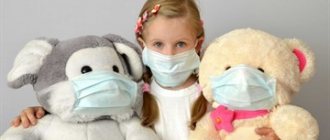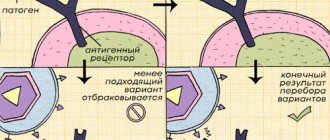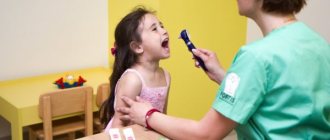- Clinical picture, symptoms
- How does an attack go?
- Whooping cough in infants
- Diagnostics
- Treatment of whooping cough
- What medications are used for treatment
- Nutrition for whooping cough
- Prevention
Whooping cough is an infectious disease that is transmitted by airborne droplets. The causative agent - whooping cough bacillus (Bordetella pertussis) - when it enters the respiratory tract, attaches to the mucous membrane, which leads to local inflammation. The disease is characterized by a spasmodic cough and increased mucus production. The disease is especially dangerous for young children.
Clinical picture, symptoms
Symptoms of whooping cough most often appear 2 weeks after infection, but the incubation period can last from 3 to 87 days.
On average, whooping cough lasts for 7 weeks (range 3 weeks to 3 months).
The course of the disease consists of 3 periods:
- catarrhal - the temperature rises, a dry cough, runny nose, sneezing appears;
- period of spasmodic cough - soreness, swelling in the throat, noisy breathing, convulsive cough with sputum production, chest discomfort;
- recovery – weakening of symptoms, restoration of normal breathing.
At the peak of the disease, the patient experiences maximum discomfort due to impaired respiratory function. Coughing attacks intensify at night or in the morning, sometimes the spasms are so strong that they end in vomiting.
The attacks are serial in nature for 2-15 cycles, they are replaced by a deep breath with a whistle (reprise), after which the attack is repeated.
The height of the disease occurs 10-14 days from the onset of the first symptoms. By this period, the toxin reaches the blood and bronchial lumen. In addition to disorders of the respiratory system, the central nervous system is affected. The patient's sleep and appetite are disturbed. The nervous reaction is especially pronounced in children. In the atypical form, acute coughing attacks are not observed. Symptoms of the disease are erased, which makes diagnosis more difficult. A sign of atypical whooping cough may be a prolonged, severe cough. Most often, the disease occurs in this form in vaccinated people.
Symptoms and treatment of whooping cough in children. Recommendations for parents
Both adults and children can get whooping cough. Immunity against this respiratory infection is developed only after a person has been ill once. In children, the manifestations are more severe, and complications can be very serious, including death. The vaccine is given in the first months of life. It does not guarantee complete protection against infection, but in vaccinated children the disease occurs in a much milder form. Doctors recommend that parents, when caring for children with whooping cough, protect them as much as possible from any factors that provoke a suffocating cough.
Features of whooping cough
The causative agent of this disease is whooping cough (a bacterium called Bordetella). The infection affects the trachea and bronchi.
The respiratory tract is covered with the so-called ciliated epithelium, the cells of which have “cilia” that ensure the movement of mucus and its removal to the outside. When they are irritated by toxic substances secreted by whooping cough pathogens, the nerve endings transmit a signal from the epithelium to the brain (to the area responsible for coughing). The response is a reflex cough, which should push the source of irritation out. Bacteria are firmly held on the epithelium due to the fact that they have special villi.
It is characteristic that the cough reflex is so entrenched in the brain that even after the death of all bacteria, a strong urge to cough continues to persist for several more weeks. The waste products of pertussis bacteria cause general intoxication of the body.
Warning: Humans do not have innate immunity to this disease. Even an infant can get sick. Therefore, it is so important to protect him from contact with adults who have a strong, persistent cough. It may well be a sign of whooping cough, which in an adult, as a rule, does not have other characteristic manifestations.
A person’s susceptibility is so great that if a baby gets sick, the rest of the family will definitely become infected from him. Whooping cough lasts 3 months while the cough reflex exists. In this case, the disease has virtually no symptoms for about 2 weeks. If you somehow manage to establish in the very first days that the pertussis bacterium is present in the body, then you can quickly suppress the disease, since the dangerous cough reflex has not yet had time to take hold. Usually, symptoms of whooping cough in children are detected already at a severe stage. Then the disease continues until the cough gradually goes away on its own.
How does infection occur?
Most often, children under the age of 6-7 years become infected with whooping cough. Moreover, in children under 2 years of age, the likelihood of infection is 2 times higher than in older children.
The incubation period for whooping cough is 1-2 weeks. For 30 days, the child should not visit a child care facility or have contact with other children, as whooping cough is highly contagious. Infection is only possible through airborne droplets during close contact with a sick person or bacteria carrier when he sneezes or coughs.
Outbreaks of the disease occur more often in the autumn-winter period. This is explained by the fact that whooping cough bacteria quickly die in the sun, and the length of daylight in winter and autumn is minimal.
Forms of whooping cough
When infected with whooping cough, the disease may occur in one of the following forms:
- Typical - the disease develops consistently with all its inherent signs.
- Atypical (erased) - the patient coughs only slightly, but there are no severe attacks. For some time, the cough may disappear altogether.
- In the form of bacterial carriage, when there are no signs of the disease, but the child is a carrier of bacteria.
This form is dangerous because it can infect other people, while parents are confident that the baby is healthy. Most often, this form of whooping cough occurs in older children (after 7 years) if they have been vaccinated. The baby also remains a bacteria carrier after recovery from typical whooping cough until 30 days after the infection entered his body. Whooping cough often manifests itself in such a latent form in adults (for example, workers in child care institutions).
The first signs of whooping cough
At the initial stage, the disease does not cause much concern for parents, since the first signs of whooping cough resemble a common cold. The baby develops severe chills due to rising temperature, headache, and weakness. Snot appears, and then an intensifying dry cough. Moreover, ordinary cough remedies do not help. And only after a few days symptoms of typical whooping cough may appear, which gradually intensify.
Periods of illness and characteristic symptoms of whooping cough
There are the following periods for the development of whooping cough symptoms in a child:
- Incubation. The infection has already occurred, but there are no first signs of the disease. They appear only 6-14 days after the bacteria enter the body.
- Premonitory. This is a period associated with the appearance of precursors of whooping cough: a dry, gradually increasing (especially at night) cough, a slight increase in temperature. At the same time, the child feels well. But this condition lasts 1-2 weeks without change.
- Spasmodic. There are attacks of convulsive cough associated with an attempt to push out what is irritating the respiratory tract, and it is difficult to inhale air. After several coughing exhalations, a deep breath follows with a characteristic whistling sound (reprise), which occurs due to a spasm of the larynx in the vocal cords. After this, the baby shudders convulsively several times. The attack ends with the release of mucus or vomiting. Coughing attacks with whooping cough can be repeated from 5 to 40 times a day. The frequency of their appearance is a characteristic of the severity of the disease. During an attack, the child's tongue sticks out and his face is red-blue. The eyes turn red because the blood vessels burst due to tension. Breathing may stop for 30-60 seconds. This period of illness lasts approximately 2 weeks.
- Reverse development (resolution). The cough gradually weakens, attacks appear for another 10 days, the pauses between them increase. Then severe symptoms disappear. The child coughs a little for another 2-3 weeks, but the cough is normal.
Note: In infants, painful attacks do not last as long, but after several coughing movements, breathing may stop. Oxygen starvation of the brain causes diseases of the nervous system and developmental delays. Even death is possible.
Possible complications
Complications of whooping cough can include inflammation of the respiratory system: lungs (pneumonia), bronchi (bronchitis), larynx (laryngitis), trachea (tracheitis). As a result of narrowing of the lumen of the respiratory passages, as well as spasms and swelling of tissues, death can occur. Bronchopneumonia develops especially quickly in children under 1 year of age.
Complications such as emphysema (bloating) and pneumothorax (damage to the lung wall and air leaking into the surrounding cavity) are possible. Severe tension during an attack can cause umbilical and inguinal hernias and nosebleeds.
After whooping cough, due to cerebral hypoxia, tissue damage to individual centers sometimes occurs, resulting in hearing impairment or epileptic seizures in the child. Seizures, which also occur due to disruption of brain function, are very dangerous and can lead to death.
Due to strain when coughing, damage to the eardrums and bleeding in the brain occurs.
Diagnosis of whooping cough in children
If a child's whooping cough occurs in a mild and atypical form, diagnosis is very difficult. The doctor can assume that the malaise is caused by this particular disease in the following cases:
- the child’s cough does not go away for a long time, the symptom only intensifies, while the runny nose and fever stopped after 3 days;
- expectorants do not have any effect; on the contrary, the state of health worsens after taking them;
- Between coughing attacks, the baby seems healthy and has a normal appetite.
In this case, to make sure that the patient has whooping cough, a bacteriological culture of a throat smear is done. The difficulty is that the bacterium is held quite firmly by the ciliated epithelium and is not removed outside. The likelihood that even in the presence of whooping cough pathogens they can be detected using this method is reduced to zero if the child has eaten or brushed his teeth before the procedure. They will be completely absent from the sample if the baby was given even an insignificant dose of antibiotic.
A general blood test is also done, which reveals a characteristic increase in the content of leukocytes and lymphocytes.
Methods for diagnosing whooping cough bacillus are used using a blood test for antibodies (ELISA, PCR, RA).
Warning: If the characteristic symptoms of whooping cough are present, the child must be isolated to avoid infecting other people. In addition, his situation may worsen after communicating with people with colds or flu. Even after recovery, the body is weakened, the slightest hypothermia or infection causes severe complications of whooping cough.
Treatment of whooping cough in children
Whooping cough is treated mainly at home, except when it affects babies under 1 year of age. Their complications develop rapidly, and the baby may simply not have time to save. A child of any age is hospitalized if complications arise.
First aid at home for whooping cough
During a coughing attack, the baby should not lie down. He needs to be planted immediately. The room temperature should be no more than 16 degrees. You should turn off the heating completely and use a sprinkler to humidify the air.
It is important to calm and distract the baby with the help of toys and cartoons. Since the cause of cough is stimulation of the nerve center of the brain, fear and excitement provoke increased coughing and spasm in the respiratory tract. At the slightest deterioration of the condition, it is necessary to urgently call an ambulance.
How to alleviate the condition and speed up recovery
A sick baby needs to walk every day to prevent brain hypoxia and improve breathing. At the same time, we must remember that it can infect other children. The patient should not be nervous.
An attack can be triggered by improperly organized nutrition. It is necessary to feed the baby often and little by little, mainly with liquid food, since the chewing movement also causes coughing and vomiting. Warning: It is under no circumstances recommended to self-medicate or use “grandmother’s remedies” to get rid of a cough. The nature of the cough in this case is such that heating and infusions do not get rid of it, and an allergic reaction to plants can lead to a state of shock.
Treatment with antibiotics
Whooping cough is usually detected at a stage when the cough reflex, which represents the main danger, has already developed. In this case, antibiotics do not help.
At the stage of the appearance of precursors of the disease, the baby is given only an antipyretic medicine if there is a slight rise in temperature. You cannot give him expectorants when a dry paroxysmal cough appears on your own, since the movement of sputum will cause increased irritation of the respiratory tract.
Antibiotics (namely erythromycin, which does not have a harmful effect on the liver, intestines and kidneys) are used to treat children from whooping cough at a very early stage, before severe coughing attacks have yet appeared.
They are taken more often for preventive purposes. If one of your family members gets whooping cough, taking an antibiotic will protect the children from the action of the bacterium. It kills the germ before a cough develops. An antibiotic will also help adult family members caring for a sick baby not to get sick.
Prevention
Since whooping cough is very contagious, when cases of the disease are detected in a children's institution, examination and preventive treatment of all children and adults who were in contact with the patient are carried out.
Infection of whooping cough in infants is especially dangerous. Therefore, it is necessary to limit the child’s stay in crowded places and communication with unfamiliar children and adults. If a child is brought from the maternity hospital, and one of the family members is sick, it is necessary to completely exclude his contact with the baby.
The main preventive measure is vaccination. It reduces the risk of infection. In case of illness, whooping cough is much easier.
How does an attack go?
With a spasmodic cough, the face becomes puffy and cyanotic, the neck veins protrude, and the eyes turn red. Children often stick out their tongue and bite it, causing injury to the frenulum. The attack may end with the release of viscous sputum or vomiting.
The number of attacks depends on the severity of the disease and ranges from 5 to 50 per day. This continues for 3-4 weeks. During the recovery stage, the cough loses its spasmodic nature and persists for up to 14-21 days.
If, within several months after suffering from whooping cough, a child becomes ill with ARVI, attacks of convulsive cough may recur.
Whooping cough in infants
Infants do not have attacks of spasmodic cough, but the disease occurs in a more severe form and can lead to extremely negative consequences, including death. One of the most dangerous symptoms of the disease is apnea - a short-term cessation of breathing. It can last from a few seconds to a minute.
An infant with whooping cough should not be left unattended, as there is a high risk of not noticing an attack of loss of breath.
Against the background of the disease, infants often develop pneumonia, encephalopathy, convulsions and collapse of the lung lobe are possible.
Chance of getting sick
A special feature of whooping cough is the complete absence of innate immunity to it: even a newborn can get this disease. And, in the absence of immunity, the probability of getting sick after close contact with a sick person reaches 100%. The infection is very dangerous for children under 2 years of age.
The introduction of effective infant vaccination programs has been associated with significant reductions in the incidence of pertussis and deaths from pertussis among children. Pertussis vaccine (in combination with diphtheria and tetanus toxoids) has been used as part of the Expanded Program on Immunization (EPI) since its inception in 1974. However, whooping cough is still a common cause of death among infants worldwide and remains a public health concern even in countries with high vaccination coverage. WHO estimates that in 2008, there were 16 million cases of whooping cough worldwide, and 195,000 children died from the disease. In 2013, whooping cough still caused approximately 63,000 deaths among children under 5 years of age. Epidemic cycles of pertussis occur every 2–5 years (usually 3–4 years), even after effective immunization programs have been implemented and high vaccine coverage has been achieved. That is why routine vaccination against whooping cough remains one of the highest priority sections of immunoprophylaxis.
Diagnostics
The greatest difficulty is in diagnosing mild and atypical forms of the disease.
What a parent should be wary of:
- prolonged dry cough without symptoms of runny nose and fever;
- no improvement after taking expectorants.
Important: During a cold, the symptoms of whooping cough and the likelihood of developing pneumonia intensify.
Diagnosis is carried out based on patient complaints. To confirm the diagnosis, examinations are prescribed:
- general blood analysis;
- bacteriological - taking a smear from the mucous membrane of the respiratory tract or sputum secretions and further examination;
- immunofluorescent – detection of antibodies;
- hemagglutination - the study of red blood cell adhesion;
- X-rays of light;
- pulmonary
Diagnostic methods
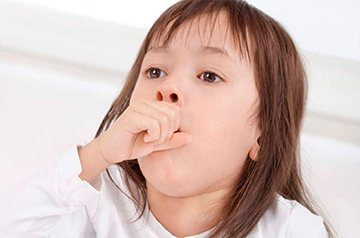
It is quite difficult to diagnose whooping cough visually, so if such an infection is suspected, a special microbiological analysis is prescribed. If during its course the bacterium Bordetella pertussis is detected, the diagnosis is confirmed.
The microorganism is extremely unstable in the external environment (it dies when exposed to sunlight, high temperatures, etc.), so it is extremely important to take the test in close proximity to the laboratory.
Otherwise, the result may be unreliable.
To carry out the analysis, mucus located on the back wall of the throat is taken from a person. The collection is made 2-3 hours after eating.
In a standard laboratory, the bacteria are cultured for 5-7 days, only after this time can a final diagnosis be made.
Modern medical centers use the immunofluorescent method; the results of the study can be obtained in just a few hours, however, the price is affordable only to a few.
What medications are used for treatment
Hyperimmune serum or antipertussis gammaglobulin shows good results in treating the disease in infants. Children over 1 year of age are prescribed antitussives with a mild analgesic effect, and in case of severe disease, antipsychotics based on chlorpromazine. Antibiotic drugs based on azithromycin are the most effective. To prevent and treat allergic reactions (allergies) caused by the causative agent of the disease, it is necessary to take antihistamines and calcium supplements.
Inhalations are prescribed to patients over 3 years of age. For the procedure, drugs are used to thin the mucus and facilitate the removal of mucus from the bronchi.
Antibiotic treatment is prescribed at the initial stage of development of whooping cough. During this period, it is still possible to suppress the pathogen. However, due to the difficulty of early diagnosis, drugs in this group are practically not used to treat children over 3 years of age.
The use of sedatives is indicated to relax the muscles of the respiratory system and reduce nervous tension.
Should children be vaccinated against whooping cough?
Today there is a tendency in society to refuse routine vaccination of children. And information about the possibility of developing the disease after all vaccinations contributes to this. But doctors insist on the need for vaccination because:
- Whooping cough is extremely dangerous for babies under one year old; in patients of this age group, it can cause respiratory arrest and death. Vaccination protects the child from a dangerous disease during this period.
- According to statistics, whooping cough that occurs after DTP vaccination is easier than without it. The cough in such patients lasts much less, and complications occur less frequently.
- Vaccination has reduced the mortality rate from whooping cough by 45 times.
Vaccination significantly reduces the risk of developing infection and complications of the disease, so it is advisable to vaccinate children according to age in accordance with the recommendations of specialists.
Nutrition for whooping cough
Particular attention should be paid to the patient's diet. Despite the deterioration in appetite, it is necessary to follow a meal schedule and divide it into small portions.
Every half hour the child should eat at least one spoon.
What to exclude:
- products with strong or strong tastes;
- allergens;
- sour and spicy foods;
- hard dry food (crackers, cookies, cereal).
Dishes with a soft texture and neutral taste are best suited. In this case, a mixer or blender will help out, with which you can bring the food to the consistency of puree.
To avoid dehydration, it is necessary to monitor the water balance and give as much fluid as possible, and if vomiting occurs regularly, inject it.

